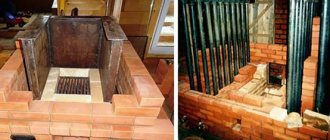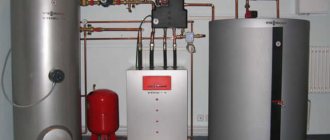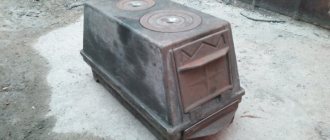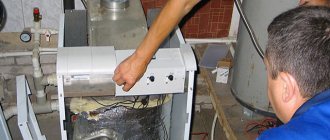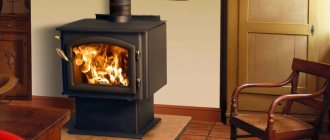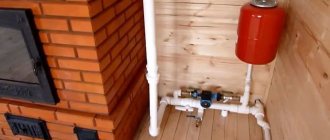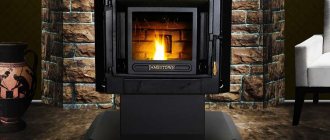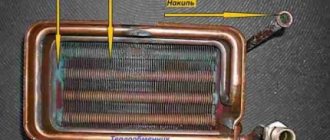It is difficult to overestimate the importance of a chimney for optimal operation of a heating unit. The main task of this device is to remove combustion products from the furnace into the atmosphere. At the same time, the following tasks must be solved:
- Obtaining a uniform thermal regime in the house throughout the day.
- Optimal fuel combustion mode taking into account its economical consumption.
- High-quality removal of combustion products from the furnace and preventing them from entering the residential area of the building.
The solution to this triune problem is ensured by the correct design solution of the thermal unit itself and its high-quality maintenance during operation.
The chimney plays an important role in this case. The effectiveness of this device is determined by several important factors:
- Correct selection of the cross-section and dimensions of the chimney. With a square or rectangular pipe shape, the flow of flue gases, which rises upward in a spiral, forms stagnant zones in the corners. They are the first to form soot deposits. The size of the channel must be one and a half times larger than the combustion hole in the furnace, the minimum dimensions of a square smoke channel are 140x140 millimeters, and the cross-sectional area of a round one must be no less than a square one in the indicated dimensions. The total length of the smoke channel is required to be more than 5 meters. The length of the horizontal section is allowed no more than one meter.
To improve draft, liners are often installed in a smoke channel of square or rectangular cross-section, which to some extent reduces the formation of soot.
- The material from which the chimney is constructed. In this case, two factors are important - the quality of the internal surface of the smoke channel and the thermal conductivity of the material from which it is made. In the first case, the influence of irregularities, in addition to reducing the flow speed, affects the ability to deposit soot. The high thermal conductivity of the pipe material contributes to the rapid cooling of furnace gases, and consequently to increased condensation and deposition of soot on the wall.
- The level of heat losses during operation. Insufficient draft in the chimney negatively affects the degree of fuel combustion, which leads to increased clogging of the smoke channel. And the ignition of soot in a chimney is often tantamount to a natural disaster.
The combination and interaction of the above factors determines the success of the smoke exhaust system.
We deliberately omit a number of rules and important factors in the design of a chimney, concentrating the reader’s attention precisely on the causes and consequences of the formation of soot deposits.
The article describes various methods on how to clean a chimney from soot with your own hands, including without climbing onto the roof.
Why clean the chimney and stove?
A soot deposit forms in the stove and on the walls of the chimney. Gradually, the draft becomes too weak and it is no longer possible to operate the stove normally. Fumes enter the room, which is very dangerous.
Soot and dust are the main causes of fire. Often a fire starts in the chimney. Combustion products fall through the cracks onto the wooden floor structures. That's how it goes.
Soot inside the chimney
The chimney can also become clogged from the top. Especially if the pipe is not covered with a deflector. In summer, birds or wasps can easily build nests there.
An increased soot content in the smoke exhaust duct may be a consequence of errors in the construction of the furnace. Somewhere the pipe narrows, somewhere there is an extra turn. The slightest mistake increases the formation of soot in such places.
Regular cleaning is necessary to remove all combustion products and other debris from the chimney. This will avoid narrowing the smoke exhaust channel and avoid a fire.
Causes of soot
Fuel combustion is accompanied by an oxidation reaction, which occurs under conditions of high temperature and a stable supply of oxygen. If at least one of these conditions is not met, soot is formed: this substance is a consequence of insufficient oxidation of carbon. A visual sign of the appearance of soot is the black color of the smoke coming out of the chimney. This indicates the presence of soot particles in its composition, the main part of which settles in the chimney (most often at turns). Sometimes people don't understand why the stove smokes. And often, the appearance of smoke from the stove is caused by soot in the chimney.
This process is activated in the following cases:
- Insufficiently dry firewood . If the firewood loaded into the firebox has a high moisture content, then the first time the firebox is fired it dries out. This is accompanied by the consumption of additional energy, which reduces the operating temperature by an order of magnitude. As a result, due to underheating of the carbon, a large cloud of black smoke is formed. If such cases are a stable trend, the chimney will gradually become clogged.
- Plastic debris and plastic bags getting into the firebox . It is advisable not to allow this to happen. A lot of soot is produced by scraps of plywood, chipboard, and OSB, which contain glue. Its combustion is accompanied by the release of dense smoke, which leads to rapid clogging of the chimney.
- Low level of traction . Sometimes they reduce the air supply to increase the burning time: firewood in this mode slowly smolders. Another reason may be insufficient chimney height. In addition, the accumulation of significant layers of soot in the pipe leads to a decrease in draft.
The chimney can also become dirty when using certain types of firewood. This is especially true for spruce and pine, which contain large amounts of resin. There is not always finance for expensive oak or other hardwoods. However, any home owner can take care of proper dryness of firewood. A good option is to get a spacious firewood shed. This will make it possible to first select the most seasoned and dried firewood. At this time, fresh logs will be able to dry to the proper condition.
Frequency of chimney and stove cleaning
How often should I clean? This information can be found in the table:
| Type of work and equipment | When to do it |
| Prevention of smoke ducts and chimney (visual inspection): | |
| Any equipment | After installation, before start-up or after repair |
| Seasonal equipment | Start of the heating season |
| Gas furnaces and boilers | At least 2 times a year, after 2 years - at least 1 time a year |
| Brick chimney | At least once a quarter |
| Other types of chimneys | At least once every 12 months |
| Chimneys of heating and heating-cooking stoves | Beginning, end and middle of the heating season |
| Chimney cleaning – elimination of deficiencies identified during inspections and additionally: | |
| B for heating and cooking (intermittently) | At least once a quarter |
| In continuous furnaces | At least once every 2 months |
| In ovens for continuous cooking | Every month |
| Cleaning the heads from ice – at least once every 2 months | |
How to clean soot from a chimney when it is already clogged? Below are step-by-step instructions.
How to clean tar from a boiler? Tips for all occasions
- The first sign that the chimney duct is clogged is darkened smoke coming out of the chimney. When heating equipment is operating normally and suitable dry wood is used, the smoke will be clear or white.
- The second sign is the absence of the sound of burning wood. In addition, the fire in this case will have a dark orange hue.
Before cleaning the chimney in the stove with a Chimney Sweeper log, you need to carefully inspect the chimney for any fallen bricks, various debris or bird nests. It is best to burn such a briquette on hot coals. Additives that enter the chimney remain there for about two weeks, and during this period soot deposits fall into the firebox. After this period, it is advisable to clean the structure manually so that soot does not remain in the system.
The most incredible way to get my hair back!
This is just a DISASTER ! And after all, my hair did not start falling out in one day, but systematically - day after day I watched how the hair left my head: while combing, washing, even while sleeping. (read more…)
Mechanical and manual cleaning
For mechanical cleaning of chimneys today, the same tools are used as 200 years ago. The technology itself has also not undergone major changes. Cleaning is carried out from the roof side and from the stove side.
Tools and materials
To clean the roof side use:
- rope or steel cable;
- hard metal brushes and weights;
It is important that the load has the correct center of gravity. Otherwise it may get stuck. It is ideal to use a round metal core as a load. It is they who break through the blockage. And only then do the brushes come into use.
If you don’t have a suitable brush at hand, you can make one yourself from an old plastic bottle. Step by step instructions below.
How to make a ruff with your own hands?
- Take a plastic bottle and cut 150 mm from the top. Make cuts along the top part in 15 mm increments. The length of the cut is selected depending on the diameter of the pipe. If the pipe diameter is 100 mm, then the brush diameter should be 130 - 140 mm.
- Drill a hole in the center of the plug. Screw the plug into place and bend the petals.
- The first brush is ready. Now we do the second one in exactly the same way.
- Find a suitable load. Its weight should be sufficient for the brush to pass through the chimney.
- Tie the load to a strong cord or steel cable. Thread the other end of the cord into the brush plugs. The brushes should be positioned towards each other.
- Take the rest of the bottle. Cut off the bottom. It turns out to be a cylinder. Cut it lengthwise. Insert it between the brushes. The length of the cylinder should be about 150 mm. Give it a diameter equal to half the diameter of the brush. Secure with a stapler.
- Tie a knot over the top brush plug. The tool is ready.
The process of making a brush with your own hands
There is another option for making a brush with your own hands:
DIY brush in the form of a brush
Roof side cleaning
The whole process consists of 6 stages:
- Prevent soot from entering the room. To do this, cover the firebox with a wet cloth and close all hatches.
- Prepare in advance and use all necessary equipment for its intended purpose, comply with all safety requirements when working at height. You will need: safety glasses, closed non-slip shoes, gloves, insurance. It is prohibited to carry out work in rain or strong wind. And also under the influence of drugs, alcohol and other drugs.
- Remove the head and inspect the channel. If necessary, remove debris with a broom.
- The first pass is made using a weight. It will clean the chimney from large contaminants.
- After this, install the brushes and clean the channel walls from soot. There's no need to rush. This is not a difficult process, but it is a messy and time-consuming process.
- The last stage is cleaning the inspection chambers.
Cleaning the chimney from the stove side
The previous method will allow you to clean the channel only up to the first turn. Another tool will help you further clean the stove from soot without disassembling it. You can't use gravity.
The oven must have special hatches for cleaning. To do this, use another tool. A special brush with a rigid but flexible fiberglass cable will help you clean an area 3–5 m long. This set is sold in hardware stores.
There is also a more specific tool:
Chimney cleaning tool
This device allows you to clean a longer area. It is easiest to clean the external chimney. But only if it is assembled correctly.
Step-by-step instruction:
- Unscrew the plug. Clean it from dirt, grime and debris.
- If the pipe is made of stainless steel, then using a metal brush is strictly prohibited.
- We attach a suitable brush and perform cleaning, gradually moving the brush upward.
- The firebox itself is cleaned in the same way. The flexible but rigid support allows you to push the brush far enough.
- The collected soot is removed. And they carry out minor chimney repairs. It is important to remember to replace the pipe head.
The process of cleaning a solid fuel boiler from tar, tar and soot:
- A layer of such deposits 1–2 cm thick can appear within a week. And within a month, the cross-section of the smoke passage will decrease so much that it will affect the draft. Fouling of the heat exchanger will lead to its thermal insulation, and the boiler will stop heating water.
- The main danger from the accumulation of soot deposits, especially plastic ones, lies in their possible ignition during boiler firing. This can lead to a serious fire, as the chimney and parts of the boiler can burn out and collapse.
Cleaning the chimney is not the most difficult, but very important operation that can prevent smoke from entering the living space. You can do this work yourself, having figured out how to clean the fireplace from soot, but if you lack confidence in your own abilities, it would be better to use the services of a professional chimney sweep.
Chemical cleaning
Regular preventative maintenance using special chemicals will help simplify the mechanical cleaning process. The principle of action of these funds varies. But the essence is the same: to clean existing deposits and prevent the formation of new ones.
The principle of cleaning a chimney with chemicals
These chemicals are discussed in more detail below.
“Smoke”
The most common remedy in this group is called “Smoke”. , Russia. There are 3 products produced under this brand name:
- cardboard box for the combustion chamber;
- cleaner in the form of a log;
- product in the form of granules for pellet boilers.
Using these products is very simple: just place them in the firebox and set them on fire. When they burn, they clean the chimney. As a result, some of the soot and other deposits will fall off, and the other part will fly out into the chimney along with the smoke. Moreover, the chemical will remain active for another 14 days. And the effect of its use lasts for 3 months.
It is recommended to carry out such a procedure regularly. Without waiting for the formation of powerful deposits. The minimum recommended frequency is once every 2 months.
HANSA products
The German company HANSA has focused its efforts on the fight against creosote. This is the very sticky base on which the soot sits.
The drug has a double effect. On the one hand, it promotes more complete combustion of fuel. Due to this, practically no soot is formed. On the other hand, at high temperatures it reacts with creazote. As a result, it loses moisture and all growths crumble.
In our country, these chemicals are better known under the brand name “Chimney Sweep”. This product can be purchased in the form of a bulk mixture or already packaged in bags.
Use it as follows:
- Used for prevention: 1 - 2 measuring cups (included in the kit) are added to the fuel during startup of the furnace every 4 - 5 fires.
- Used for cleaning: burn the required amount in the firebox.
There is also a Chimney Sweeper log. It is placed in a heated firebox and set on fire. It should burn completely. It is recommended to carry out such cleaning every 30 days.
These chemicals can even handle a brick pipe. Usually it is its cleaning that poses the biggest problem due to the porous structure of the brick itself.
Cleaner Kominichek
Country of origin: Czech Republic. The product is also popular in Russia. This is a crystalline mixture in 14 g sachets.
Kominichek cleaning agent
- The product turns soot into a substance that burns even at low temperatures.
- This product will not cope with heavy plaque. The soot layer should not exceed 2 mm.
- Carry out the treatment only with the combustion chamber tightly closed. The product is toxic.
- This product is not suitable for cleaning a fireplace.
Other means
There are many such tools. Experts recommend trying several and choosing the best one for yourself. In addition to those already described, the following are in demand:
- Anti-carbon powder PHC. It is burned together with firewood. For one ton you need only 150 - 200 g.
- A mixture of saltpeter, copper sulfate and coke is poured onto the smoldering coals. Maximum dosage – 200 g. Promotes effective soot peeling.
- Log - cleaner "Chistotrub". The log must be burned in the firebox. The effect of the drug continues for 3 to 4 days after use.
Folk remedies for cleaning chimneys
It is also possible to clean the chimney from soot using folk remedies. And their effectiveness has been proven by many generations of our ancestors.
Boiling water
The simplest way to clean soot from a pipe is regular boiling water. It can handle even very heavy raids. To do this, before lighting the stove, it is enough to pour several liters of boiling water into the pipe from above. The remaining soot will fly out into the chimney along with the smoke.
Salt
Another old-fashioned way is to add a couple of handfuls of ordinary table salt to the firewood. But this remedy is only suitable for prevention. He is unable to cope with strong growths.
Naphthalene
Regular mothballs will also help. It is enough to throw 1 - 2 tablets into the fire. The soot will fall off and burn. Or it will go up the chimney along with the smoke.
But this method has one significant drawback. Naphthalene has a very specific smell. It won't be easy to get rid of it later. And not everyone likes him.
Potato peelings
Another effective remedy for preventing the formation of soot build-up is regular potatoes. Usually only peelings of this root vegetable are used. But you can finely chop the potatoes themselves.
The peelings are placed in a well-heated firebox and burned in it. The starch evaporates and effectively dissolves soot build-up. It also prevents the formation of new ones.
A mixture of coal, copper sulfate and sulfur
The recipe is as follows:
- copper sulfate - 5 parts;
- coal - 2 parts;
- saltpeter - 7 parts.
This composition is used in small quantities, burned together with fuel. Only 200 g of product is enough for a ton of firewood. This cleaning method is not suitable for a fireplace. Vapors are toxic and should not enter the room. Therefore, the firebox door must be tightly closed.
Using special firewood
Another way to deal with carbon deposits is special firewood. For this, alder or aspen is used. Wood burns quickly and emits special fumes during combustion. They contribute to the peeling of soot from the walls and combustion.
Despite the fact that such firewood cannot be used for heating due to low heat transfer, it is still necessary to have a supply of it. From time to time, the furnace is completed by burning several of these logs.
Sparks may fly from the pipe. They can fall on neighboring buildings and cause a fire. Therefore, the pipe is protected from above with a deflector, and the combustion process of such firewood is controlled.
How can I avoid or minimize clogged pipes in the future?
To reduce problems to a minimum, just follow a number of simple recommendations:
- When softwood wood burns, too much resin is produced. Therefore, it is not recommended to use it for heating.
- The moisture content of firewood should not exceed 12%. To do this, they are first dried indoors for several days. The use of raw fuel contributes to increased soot formation. And reduces heating efficiency by 30 - 40%.
- To fire the stove, it is advisable to use wood that is at least two years old.
- The stove or fireplace should not be used to burn waste.
- From time to time it is worth completing the firebox by burning an armful of aspen or alder firewood. This is a good prevention against soot formation.
It is important to follow the schedule of preventive examinations given above. These measures will help to avoid contamination of the chimney and the creation of an emergency situation.
Prevention
Without preventative maintenance, it is impossible to achieve proper operation of the furnace. The reasons for frequent blockage of the smoke channel with soot and other contaminants are:
- use of raw firewood;
- burning plastic waste, PE, chipboard and plywood residues in a stove;
- lack of traction;
- use of spruce or pine firewood.
The best way to clean it is to follow the recommendations for using the heating system. It is important to dry the firewood well before putting it into the firebox: this way, even resinous types of wood will not cause serious harm. Do not heat with plywood boards and other building materials containing glue or varnished ones. Such residues should only be thrown into a landfill, and not burned at home.
By listening to the recommendations of specialists, you can forget about cleaning for at least six months. Today it is not necessary to call a chimney sweep and pay him. By using one of the pipe cleaning methods, you can both save money and keep your stove in order.
Prices for chimney sweep services and where to find them?
The profession of a chimney sweep is again in demand due to the fact that recently cases of fires in private homes have become more frequent. And they are connected precisely with the contamination of the chimney, as well as with its improper design.
It just seems that everything is easy. In fact, this profession takes several years to be trained. Where can you find such masters? This is where the Internet comes to the rescue. Similar announcements can be found on bulletin boards. You need to search in the services section for your region.
Another way is to contact a furnace equipment service company. Some of them provide similar services.
Prices vary depending on the specific region and the popularity of the specialist. On average, a full range of services will cost 1000 rubles per 1 m2 of cleaned pipe. Vacuum cleaning of ovens will help you get rid of soot and dust.
Video description
How vacuum cleaning of chimneys takes place is shown in the video:
Having finished the main work, remove the remaining soot in the cleaning holes using small scoops and brushes, and clean the firebox with the ashpit again. You can also use an old household or construction vacuum cleaner to prevent small particles of dirt from flying around the house.
Since it is very difficult to blindly clean a pipe in a bathhouse or residential building, it is advisable to check the quality of the work using mirrors tied to a cable. With a long chimney, this trick will not work due to the lack of light inside, but portable endoscope video cameras with a long cord that connect to a smartphone or other device via a USB portal can come to the rescue. Professionals have special equipment for quality control.
A household USB endoscope allows you to look into the most inaccessible places Source vupe.ru
Let's sum it up
The main reason for poor draft is soot in the chimney. If an accident occurs and the chimney is clogged, you can turn to a professional for help. But it happens that in a given area no one provides such services. Or they cost too much.
Then you can clean the chimney yourself. And for this you do not need to disassemble it. It is enough to stock up on tools and master some simple skills. For your own safety, you should comply with all regulatory requirements.
Cleaning a furnace chimney is a rather dangerous task. Safety must come first.
If the pipe is already clogged, then it is best to clean the chimney mechanically. He is the most reliable. And it will fix the problem as quickly as possible. It also minimizes the consequences.
But as a preventive measure, it is better to use chemical cleaning. Then an emergency situation can be avoided. Whether to use chemical reagents or folk remedies - here everyone chooses for himself. The main thing is to do this regularly.


